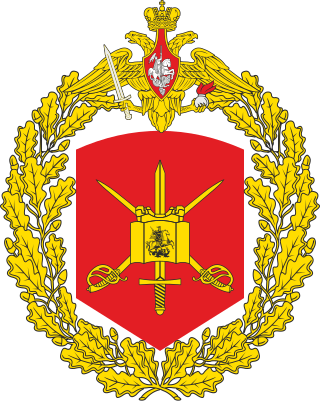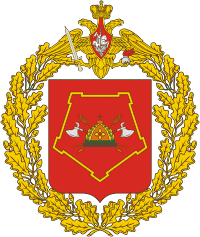History
The division draws its history from the 75th Naval Rifle Brigade formed in the end of 1941. As part of the 3rd Shock Army, Kalinin Front in 1942 the brigade participated in the Demiansk operations – the Moscow counteroffensive. For its fighting performance it became the 3rd Guards Rifle Brigade in March 1942, having spent all its time in reserve, became the 27th Guards Rifle Division in April–May 1942. With a view to the preservation of fighting and revolutionary traditions of earlier formations, the name "Omsk" which 27th Rifle Division had during the Russian Civil War had earlier was given to the new division. It included the 76th Guards Rifle Regiment (ru:76-й гвардейский стрелковый полк), the predecessor to today's 15th Separate Motor Rifle Brigade.
In the late summer of 1942, it was rushed south to help stop the German offensive into the northern Caucasus and Stalingrad. It took part in the destruction of the German 6th Army during the winter of 1942/43. During World War II the division was part of the 4th Tank Army, 1st Guards Army, the 24th Army, the 66th Army, the 65th Army and since February 1943 the 62nd Army. In April 1942 the 62nd Army became the Eighth Guards Army. [2] In July 1942 the division was part of Kalinin Front's 58th Army, alongside 16th Guards Rifle Division and two other rifle divisions. [3] The division was back with the 8th Guards Army of the 1st Belorussian Front in May 1945.
The division participated in the Battle of Stalingrad, Izyum-Barvenkovo, Donbass, Zaporozhye, Nikopol-Krivoi Rog, Bereznegova-Snigirovka, Odessa, Lublin – Brest, Poznań, Küstrin, Warsaw-Poznan and the Berlin offensive operation. For services in battle the division was awarded the honorific "Novobug" in March 1944, [4] then awarded the Order of the Red Banner and Order of Bogdan Khmelnitsky 2nd degrees. Over 10 thousand of its soldiers were awarded awards and medals, and 7 were awarded the Hero of the Soviet Union. Its commanders included Colonel Konstantin Vindushev (1942), and Viktor Glebov (1942–1945), Glebov was originally a colonel but was made a general-major in November 1942. [2]
Since 1945 the division remained as part of the Group of Soviet Forces in Germany, where it became 21st Guards Mechanised Division, then 21st Guards Motor Rifle Division on 17 May 1957. On 17 November 1964 it was renamed 27th Guards Motor Rifle Division. It remained in Germany until May 1991, when it was withdrawn to Totskoye in the Volga-Ural Military District. It has contributed many personnel for peacekeeping operations. [1]
The division was renamed the 21st Guards Motor Rifle Brigade on 1 June 2009, after the beginning of the 2008 Russian military reform. [1] In 2024 the division was formed once again from the 21st Guards Motor Rifle Brigade having 3 regiments: the 433rd Regiment, the 506th Regiment and the 589th Regiment.

The 8th Guards Order of Lenin Combined Arms Army is an army of the Russian Ground Forces, headquartered in Novocherkassk, Rostov Oblast, within Russia′s Southern Military District, that was reinstated in 2017 as a successor to the 8th Guards Army of the Soviet Union's Red Army, which was formed during World War II and was disbanded in 1998 after being downsized into a corps. Military Unit в/ч 61877.

The 1st Guards Tank Army is a tank army of the Russian Ground Forces. в/ч 73621.

The Siberian Military District was a Military district of the Russian Ground Forces. The district was originally formed as a military district of the Russian Empire in 1864. In 1924 it was reformed in the Red Army. After the end of World War II the district was split into the Western and Eastern Siberian Military Districts. In 1956 the district was reformed. In 2010 it was divided between the two newly formed Central and Eastern Military Districts.
The 1st Rifle Division was an infantry division of the Soviet Union's Red Army, it is unclear when the division was first established. Some sources indicate 1918, others indicate 1924 or 1927. The division was formed from units already stationed in Moscow as the 1st Moscow Rifle Division. It became a motorized unit in 1940.

The 35th Combined Arms Red Banner Army is a field army of the Russian Ground Forces. The army was first formed in July 1941 with the Far Eastern Front. After spending most of World War II guarding the border in Primorsky Krai, the army fought in the Soviet invasion of Manchuria in August 1945, and was disbanded shortly after the end of the war. Reformed at Belogorsk when Sino-Soviet tensions rose in the late 1960s in the Far East, the army became part of the Eastern Military District in 2010.
The 85th Leningrad-Pavlovsk Red Banner Motor Rifle Division was an rifle division of the Soviet Red Army converted to a motorised formation in 1957. It was originally formed in 1941 as the 85th Rifle Division from the 2nd Guards People's Militia Division of the Leningrad People's Militia. The 85th Division was part of the Russian Ground Forces until it was reorganised as the 32nd Separate Motor Rifle Brigade in 2009. In 2016, the 32nd Separate Motor Rifle Brigade was reorganised as the 228th Motor Rifle Regiment of the 90th Guards Tank Division.

The 2nd Guards Tank Army was a large military formation of the Red Army and later the Soviet Army, now part of the Russian Ground Forces of the Russian Federation.

The 20th Guards Combined Arms Army is a field army. In 1991, after the dissolution of the Soviet Union, the army became part of the Russian Ground Forces. Military Unit Number в/ч 89425.

The 3rd Guards Tank Army was a tank army established by the Soviet Union's Red Army during World War II. The 3rd Tank Army was created in 1942 and fought in the southern areas of the Soviet Union and Poland, then in Germany and Czechoslovakia until the defeat of Germany in 1945. Postwar, the army served as occupation troops in East Germany, went through several name changes, and was finally deactivated in 1969.

The 169th Training Centre is a division-sized training formation of the Ukrainian Ground Forces. The Training Centre's main task is to prepare young professionals and personnel under contract to the Army Forces of Ukraine.
The 3rd Shock Army was a field army of the Red Army formed during the Second World War. The "Shock" armies were created with the specific structure to engage and destroy significant enemy forces, and were reinforced with more armoured and artillery assets than other combined arms armies. Where necessary the Shock armies were reinforced with mechanised, tank, and cavalry units. During the Second World War, some Shock armies included armoured trains and air–sled equipped units.

The 38th Separate Guards Vitebskaya order of Lenin Red Banner order of Suvorov Motor Rifle Brigade is a mechanized infantry brigade of the Russian Ground Forces, part of the Eastern Military District. Military Unit в/ч 21720.
The 1st Guards Proletarian Moscow-Minsk Order of Lenin, twice Red Banner Orders of Suvorov (II) and Kutuzov (II) Motor Rifle Division was a division of the Red Army and Russian Ground Forces active from 1926 to 2002.
The 3rd Guards Volnovakha Red Banner Order of Suvorov Motor Rifle Division was a division of the Soviet Army from 1957 to around 1992. It traced its history from the highly decorated 3rd Guards Rifle Division of World War II. The 3rd Guards Rifle Division was formed from the 153rd Rifle Division.

31st Rocket Army is one of the three rocket armies within Russian Strategic Rocket Forces headquartered in Orenburg. The 31st Rocket Army was formed on 8 June 1970, on the base of the 18th Separate Rocket Corps. The 31st Army is equipped with R-36M and RT-2PM Topol intercontinental ballistic missiles.

The Soviet order of battle for Operation Uranus details the combat units of the Soviet forces that fought in Operation Uranus, the Soviet strategic counteroffensive that led to the encirclement of the German troops in Stalingrad. The order of battle lists units present on 19 November 1942, the day the operation began, from north to south.

The Southern Military District is a military district of Russia.

The 120th Guards Mechanised Brigade is a mechanised infantry brigade of the Belarus Ground Forces. It is the heir to the traditions of the Red Army 120th Guards Rifle Division which became the 120th Guards Motor Rifle Division in 1957.
The 207th Rifle Division began its combat path under unusual circumstances. It was partly formed for the first time as a standard Red Army rifle division in the spring of 1941, before the German invasion, but was never completed. A second formation began in April 1942 and was completed on June 1, after which it was sent to the Stalingrad Front. Heavily depleted in counterattacks against the north flank of German Sixth Army, by November the survivors were reassigned and the division disbanded. The 207th was formed for a third time in June 1943, and fought its way through the central part of the Soviet-German front, ending the war in the heart of Berlin in the battle for the Reichstag. The division saw postwar service in the Group of Soviet Forces in Germany.
The 227th Rifle Division was an infantry division of the Red Army, originally formed in the months just before the start of the German invasion, based on the shtat of September 13, 1939. It arrived at the front in July and was assigned to 26th Army along the Dniepr, but was fortunate to escape that Army's encirclement in September. During the next several months, the division fought as part of 40th Army in the Kursk region, operating toward Prokhorovka and Oboyan during the winter counteroffensive. It made noteworthy gains during the May 1942 offensive north of Kharkiv but these went for naught when the southern wing of the offensive collapsed. When the main German summer offensive began in late June, the division's 21st Army was directly in the path of the German 6th Army and the depleted 227th was soon destroyed on the open steppes.












